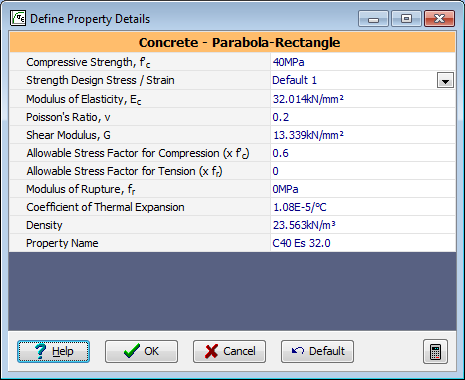Concrete Properties for Standard 17th
Description
Definition of the material properties for a section or beam is a three step process:
- Add the material type (concrete / reinforcing steel / etc.)
- Define a set of properties for that material type (compressive strength etc.)
- Allocate the material properties defined in 1 & 2 to the relevant parts of the section or beam section component.
This form performs the second of these 3 stages for concrete. As data is entered the program checks that values are within the expected range for concrete. This check will highlight any values in error by a factor of 10 or more. The displays for strength design and service load design are to the same scale, and are updated as the values in the fields are changed.
For the strength design, the stress-strain distribution is assumed to be parabolic, in accordance with the provisions of Article 8.16.2.6 of the AASHTO Standard Specifications 17th edition. The parabolic shape used is generally accepted as the closest shape in substantial agreement with test results which is practical for design purposes.
Form Graphic

Related Topic
Field Help
Compressive strength f'c
Enter the compressive strength at 28 days for the concrete. A warning will be issued if the value entered is beyond reasonable limits, but the value will not be rejected.
Strength Design stress/strain
This program allows a parabolic stress / strain distribution according to the provisions of article 8.16.2.6 of AASHTO Standard Specifications 17th edition.
To select a stress / strain curve for the concrete, click on this field to display a drop down list containing 3 options as follows:
Default 1
This is based upon the ULS stress strain curve defined in the UK bridge design code BS 5400, with due allowance made for the strengths based upon cylinder crushing tests and not cube strengths. Also the maximum strain will be taken as 0.003, and not 0.0035.
Default 2
This is based upon the ULS stress strain curve defined in the Hong Kong Highways Department design code, with the same allowances as described for Default 1 above.
Define
This may be used to define a stress / strain curve of the same form as the ones above (i.e. parabolic up to the maximum stress) but with different parameters.
Elastic modulus - Ec
Enter the modulus of elasticity of the concrete under short term (instantaneous) loading.
The default value is calculated from the formula given in Article 8.7.1 of AASHTO Standard Specifications 17th edition, based on the compressive strength specified above.
As elastic modulus, shear modulus and the Poisson's ratio are related, a change of this value will affect one of the three elasticity parameters, in this case the shear modulus.
Poisson's Ratio, ν
Enter the value for Poisson's ratio. The default value is typical for this type of material. As elastic modulus, shear modulus and the Poisson's ratio are related, a change of this value will affect one of the three elasticity parameters, in this case the shear modulus.
Shear Modulus, G
Enter the shear modulus value. As elastic modulus, shear modulus and the Poisson's ratio are related, a change of this value will affect one of the three elasticity parameters, in this case the Poisson's ratio.
Allowable stress factors for Compression / Tension
Enter the allowable stress factors for concrete in compression and tension. These values will be used for allowable stress design.
The default values are for reinforced concrete as specified in article 8.15.2.1.1 of AASHTO Standard Specifications 17th edition. The allowable tension stress for reinforced concrete members is zero (Article 8.15.3.3).
In prestressed members, for temporary stresses before losses, the compression limit is given in article 9.15.2.1 of AASHTO Standard Specifications 17th edition as 0.60. For permanent loads, the limit is given in article 9.15.2.2 (ibid) as 0.60 except for effective prestress plus dead loads, and for live loads plus half of the above permanent loads, for which the limit is 0.4.
The tension limit from article 9.15.2.2 is 0.8.
Modulus of Rupture
The modulus of rupture must be entered as a negative value or zero. The default value is obtained from Article 8.15.2.1.1 and 9.15.2.3 of AASHTO Standard Specifications 17th edition, based on the value for normal weight concrete for the entered value for compressive strength.
Coefficient of thermal expansion
Enter the coefficient of thermal expansion for use in temperature gradient calculations.
The default value is 0.000006 /°C as suggested in article 8.5.3 of AASHTO Standard Specifications 17th edition for normal weight concrete.
Density
Enter the density of the concrete.
The default value is 0.150 KIP/FT3 (or 23.56 kN/m3, which is equivalent to 2400 kg/m3) as given in Article 3.3.6 of AASHTO Standard Specifications 17th edition for plain or reinforced concrete.
Where the actual density is greater than this the tension stresses for pre-tensioned beams at transfer may be unduly conservative.
The value may depend upon the type of aggregate, the amount of reinforcement, and the degree of compaction.
Property Name
The program will supply a reference name which should provide a nearly unique identifier to the material property set. This value may be edited to give a more readily recognizable name if required.
